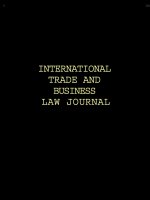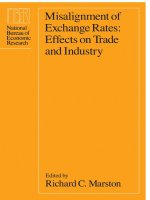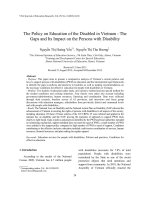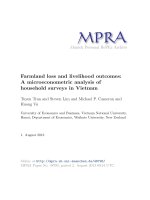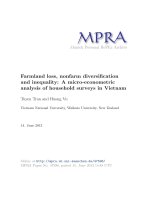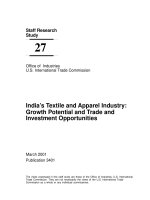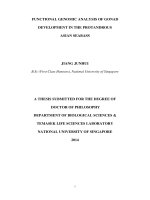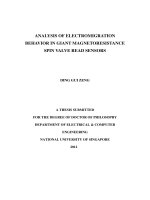Analysis of transaction costs in international trade and practice in vietnam
Bạn đang xem bản rút gọn của tài liệu. Xem và tải ngay bản đầy đủ của tài liệu tại đây (1.26 MB, 98 trang )
MIMISTRY OF EDUCATION AND TRAINING
FOREIGN TRADE UNIVERSITY
MASTER THESIS
ANALYSIS OF TRANSACTION COSTS IN
INTERNATIONAL TRADE AND PRACTICE IN
VIETNAM
Major: International Economics
NGUYEN KIM NGAN
Hanoi, 2019
MIMISTRY OF EDUCATION AND TRAINING
FOREIGN TRADE UNIVERSITY
MASTER THESIS
ANALYSIS OF TRANSACTION COSTS IN
INTERNATIONAL TRADE AND PRACTICE IN
VIETNAM
Major: International Economics
Full name
Supervisor
: Nguyen Kim Ngan
: Assoc. Prof. PhD Tu Thuy Anh
Hanoi, 2019
ERTIFICATION
I hereby certify that the thesis with the title: “Analysis of transaction costs in
international trade and practice in Vietnam” is my own research and does not
reproduce any other materials. The data indicated in the thesis is clear, accurate
and are collected from the confident sources of information.
The Author
Nguyen Kim Ngan
ACKNOWLEDGMENTS
In order to complete this thesis, besides the efforts of myself, I have
received the help, encouragement and guidance of my teachers, friends,
colleagues and family throughout the course as well as in the period of the
thesis research.
Special thanks to Assoc. Prof. Ph.D. Tu Thuy Anh, who was
dedicated to guide and help me in the process of researching and writing this
thesis.
I am grateful to the teachers in the Faculty of Postgraduate Education of
Foreign Trade University for interesting and useful lectures, for the
enthusiastic transmission of the valuable knowledge and for the best conditions
offering in the process of the course.
I would like to express sincere thanks to my colleagues working on
Commercial Department who support me with a lot of data and information
related to logistics costs of exporting shipments.
I am grateful to my family for their encouragement and supports during
the course and the period of thesis research.
This thesis studies on the transaction costs of exporting firms is not a new
but a very complicated issues required various knowledge, skills and practical
experiences. Thus, the thesis has the inevitable shortcomings and limitation. I
look forward to receiving valuable comments for improving the thesis.
Sincerely,
Hanoi, 2019
The Author
Nguyen Kim Ngan
TABLE OF CONTENTS
LIST OF ABBREVIATIONS
ABBREVIATIONS
MEANINGS
ADB
Asian Development Bank
APEC
Asia-Pacific Economic Cooperation
ASEAN
Association of South East Asian Nations
BRI
Belt and Road Initiative
FTZs
Free Trade Zones
FDI
Foreign Direct Investment
GDP
Gross Domestic Product
GST
Goods and Services Tax
GVCs
Global Value Chains
IADB
Inter-American Development Bank
LPI
Logistics Performance Index by The World Bank
LDCs
Least Developing Countries
MTB
Marginal benefit
MTC
Marginal transaction costs
OECD
Organization for Economic Co-operation and Development
PPP
Public-Private Partnership
TFA
Trade Facilitation Agreement
TFAF
Trade Facilitation Agreement Facility
UPU
Universal Postal Union
VLA
Vietnam Logistics Association
WB
World Bank
WCO
World Customs Organization
WTO
World Trade Organization
LIST OF TABLES
LIST OF FIGURES
ABTRACT
In trade, transaction costs are components directly into the price of goods
and services and are increasingly focused and paid more attention. Today, the
economy in general and businesses in particular want to compete in the world
market, it is impossible to ignore the management and control of this type of cost
so that they are as low as possible. For developing and underdeveloped countries,
transaction costs are often high due to underdevelopment of infrastructure,
science and technology. The international integration, trade barriers, qualifications
also challenges them to minimize this type of cost, thereby increasing their
commercial competitiveness.
This paper presents the current status of the transaction costs encountered by
Vietnamese exporting firms. From the collection, analysis shows that transaction
costs of Vietnam tend to decrease but remain high compared to other countries in
the region and the world. This is due to infrastructure traffic in Vietnam has not
yet caught up with the development progress of the logistics industry, transport
infrastructure system is not synchronous, connectivity is still limited between sea,
rail and road transport; lack of national and international logistics centers in key
economic areas to act as a focal point for goods distribution. The main transport
fees, surcharges and taxes constitute a barrier for the logistics industry to develop.
In addition, the policy of many ministries and transport trends makes cost cutting
more difficult… From these studies, the Thesis would like to provide solutions for
Vietnam to reduce transaction costs encountered by Vietnamese exporting firms.
INTRODUCTION
I. The important of the research
In modern economies transaction costs have become equally (and perhaps
more) important than production costs. This is quite a development considering that
early economic theory (e.g., the perfect market economy model) focused entirely on
production costs assuming that transaction costs did not exist. Implication for
economic research: It has become relatively more sensible to do research in
transaction cost dynamics rather than production cost dynamics. This is perhaps also
contributing to the surge of interest for research in corporate governance that clearly
has more to say about transaction cost dynamics rather than production cost
dynamics. You can’t manage costs effectively without taking into account the
transaction costs. Many economists like to divide costs incurred by a business into
two categories; transaction and production costs. Production costs include costs of
producing as well as distributing a good or service. Everything else is categorized
into the types of costs.
The managers can’t make right choices without analyzing transaction costs.
For examplem, a buyer wanted to purchase a colored Doppler (ultrasound machine)
for their charity hospital. However, the price of the device from well-known
companies was out of our reach. On the other hand, they didn’t want to buy a
product from some less reputed company. This led to go for a refurbished colored
Doppler.
There were dozens of sellers all around the province. We were touchy about
the model, availability of spare parts and price of the product. Our searches cost us
spending on telephone calls, letters, emails, etc. Similarly, we had to spend a lot of
time which involved an opportunity cost. All these expenses were made to purchase
a single product. What can be the volume of the cost in case of economies of scale?
In fact, without analyzing these costs, we can’t find out the exact turn out of
our deals. They become a detrimental factor in measuring the level of profits. The
profits of a business decrease with increase in transaction costs. They also reduce
the volume of our reserved capital which we can invest in specific profit yielding
opportunities.
In a world without transaction costs but with perfect markets, the penetration
ofinternational markets would be a simple matter of production cost; thus,
comparative advantages would determine which producers penetrate international
markets and when.Yet, despite remarkable technological improvements relevant to
the costs of internationaltransacting, especially with respect to communications and
data storage, and considerablerelaxation of exchange controls and the like, the costs
of international transactions aregenerally far from negligible. In particular, from
around the world there is growingevidence that reforms designed to provide the
right economic environment for the localproduction of exportables and incentives
for exporting are insufficient in themselves togenerate rapid export growth
(Keesing, 1979; Morawetz, 1981; Dean, Desai and Riedel, 1994 and Greenaway
and Morrissey, 1993). In some respects, moreover, the transaction costs of
international marketing may even be increasing over time, preventing otherwise
beneficial transactions from taking place. Unless the high transaction costs in
international marketing are recognized and appropriate strategies are designed for
dealing them, even the best of general macro economic and trade policy reforms
may be doomed to failure. The costs of reform failures are high-as are the costs of
failing to try.
Exports have played a pivotal role in the growth of the each economy. It
mainly contributes to GDP of each country, therefore, it has become imperative that
there should be a focus on not only increasing exports base but also improving their
export competitiveness in the world market. A key factor hindering export
competitiveness has been the high transaction cost involved in exports. Transaction
cost related to trade involves a host of regulatory requirements, procedures and
compliance measures; besides infrastructure-related cost- including transport cost to
bring product to the border, time and money spent in ports on border procedures,
international transportation costs and communication costs. Along with this,
documentation has become an additional burden. Transaction cost is a key
determinant of a country's competitiveness in the international market.
High transaction costs effectively nullify comparative advantage by rendering
exports uncompetitive. High transaction costs deny firms access to technology and
intermediate inputs, preventing their entry into, or movement up, global value
chains. High transaction costs also erode consumer welfare narrowing the range of
good and services on offer and pushing up prices. While transaction costs do not
alone explain the development pathways of economies, they are a major factor
explaining why some countries are unable to grow and diversify. The range of
policies that affect transaction costs is broad. Although transaction costs are
ubiquitous, they are not immutable. Action can, and is, being taken to reduce
transaction costs. Policy reforms are yielding positive impacts, although these
cannot be assumed, with research suggesting that the lowest income countries stand
to gain the most from enacting such reforms. Much work remains to be done to
reduce transaction costs further and integrate countries more completely into the
global economy, but there are positive reasons to believe that developing countries
and their partners are taking this issue seriously. Normally, 95% the foreign trade (in
volume) of country passes through sea ports. The shipping lines provide
transportation service to importers and exporters from one country to another
country. The cargo handling cost and shipping charges determine the economical
viability of export goods. The transaction costs of the import-export shipment are
important factor in the international trade. Therefore, this thesis is important to
understand economical impact of foreign trade of various countries.
From the above mentioned reasons, the author chooses the topic “Analysis of
transaction costs of international trade and practice in Vietnam” for research.
Strating from theoretical basis and actual situation of transaction costs in
Vietnamese exporting firms, the author shall make some necessary recommendation
on policy and practical action in order to reduce the transaction costs, contributing
to sustainable development of the country.
II. Object and scope of research
Export is one of the important economic activities of the country. The exporter
has to pay cargo handling cost and other charges to concerned service providers.
This high logistics cost impact adversely to business. Therefore, the object of
research is to analysis transaction cost in Vietnamese exporting firms in practice.
The objectives of the thesis are analysis the overview of transaction costs and
the important of transaction costs in trading growth in whole economy, particular in
exportation; the practice of transaction costs in Vietnam exporting firms and give
the reasons why the transaction costs are high in Vietnam exporting firms.
Transaction costs are analysed through one case study of Vietnamese company
(due to no genaral dates of transaction costs). After determining all factors which
affect transaction cost in Vietnam trade, from analysis and synthesis, the thesis shall
show that the transaction costs are high for Vietnam exporting firms. From that, the
thesis shall make several recommendations for reduction of transaction costs in
Vietnamese exporting firms.
III. Research methods
The research is conducted based on the methods of collecting, analyzing and
synthesizing information, processing statistical data and evaluating actual situation
of Vietnam in comparison with that of other countries in the world. The thesis also
uses case study method to have a realistic view of the issues by generating the
experience of other countries in transaction cost and analyzing outstanding case in
Vietnamese firm.
IV. Expected results
The research is expected to make several contributions to theoretical and
practical basis as follows:
-
Generating theorical base for the transaction costs
Determining factors impact on the transaction cost
Analyzing and evaluating the transaction costs in Vietnam trading firms
Making recommendations on improving transaction costs of Vietnamese firms.
V. Structure of the research
A part from the Introduction and the Conclusion, the research is divided into
three chapters as follows:
Chapter 1: Theoretical background of transaction costs
Chapter 2: Transaction costs encountered by Vietnamese exporting firms
Chapter 3: Recommendations for lowing the transaction costs encountered by
Vietnamese exporting firms.
CHAPTER 1: THEORETICAL BACKGROUND OF TRANSACTION
COSTS
1.1. Definition of transaction costs
1.1.1 Definition of transaction costs according to economits’s viewpoint.
What are the transactions and what are the transaction costs?
Scholars have different ideas about the definition of transaction in different
periods. For example, John R. Commons (1931) came up with a generalized
concept about transaction before Coase’s literature “The Nature of the Firm” has
been published. According to Commons, transactions are just the transfer and obtain
of object future ownership between two persons, and the substance of transaction is
the ownership transfer, not the object itself moves from one to another. A transaction
occurs when a good or a service is transferred across a technologically separable
interface, one stage of activity terminates and another begins (Oliver E. Williamson,
1981). It is generally stated that, transaction is just the exchange of goods or service
by the medium of currency. But to a narrow definition, transaction is an activity of
buying or selling objects or interests among people; and to a universal definition, all
the activities among enterprises, persons, enterprise and person can be named as
transaction.
Ronald Coase (1937), the economist formulated the first ideas about
transaction costs more than 70 years ago, mentioned “Without the concept of
transaction costs, which is largely absent from current economic theory, it is my
contention that it is imposible to understand the working of the economic systems,
to analyze many of its problems in a useful way, or to have a basis for determining
policy” [Coase 1988a, p.6].
In economics aspect, transaction costs are as the fees paid by buyers, but not
received by sellers, or the fees paid by sellers, but not received by buyers. In finance
aspect, transaction costs refer to the premium above the current market price
required to attract additional sellers into the market.
According to econimists’s studies, defination of transaction costs are described
and developed through time. There are three economists have been rewarded the
Nobel Prize for Economics for their contribution to the theory of transaction costs
namely Ronald Coase, North, and Williamson.
Firstly, Ronald Coase described transaction costs as unavoidable costs of
doing business, “the cost of using the price mechanism” in “The Nature of the
Firm”. Coase used the term “transaction costs” to refer to costs of communicating,
encompassing all of the impediments in bargaining. Given this definition,
bargaining necessarily succeeds when transaction costs are zero.
Ronald Coase developed the notion of transaction costs as a way of explaining
the emergence of the firm within an exchange economy and also as a way of
understanding the particular structure and governance framework of firms in
different sectors and under different circumstances. He asked: why does a firm
emerge at all within an exchange economy, where the different factors of production
(land, labour and capital) necessary to make goods or provide services can be freely
exchanged? If the answer is to do with the nature of entrepreneurialism (specifically
the ability of entrepreneurs to bring together factors of production which would not
easily come together through the market mechanism alone), then why is this type of
coordination achieved in some cases through entrepreneurialism and in other cases
through the price mechanism? Why was it that, in some agricultural systems, bread
would be made as a result of a series of exchanges between wheat farmers, millers
and bakers, whereas, in other systems, all these functions would be vertically
integrated within a single firm?
According to him, there are two main types of transaction costs, internal
transaction costs and external transaction costs, and firm size depends directly on
the nature of the transaction. External costs include the paid costs of getting the
information, the opportunity cost of time taken up in searching…; whereas internal
costs include the mental effort devoted to undertaking the search and sorting the
incoming information… The firms must make a comparison between internal and
external transaction costs and choose the lowest cost which enables it to increase
profits.
Figure 1: Internal and external transaction
Cost
External
b
a
Internal
Source: International Journal of Engineering and Management Sciences
The horizontal line (a) is the cost of doing any transaction within a firm and it
is the fix cost, so any internal transaction costs are in effect the same. Coase argued
that the firm will want to do all the work internally where line ( a) is below line (b),
or in other words, the transaction costs for exchange within the internal firm are
lower than for exchange through the market, so that the firm size will grow. The
opposite, transaction costs for exchange within internal system are higher than for
exchange through the market, the firm will be downsized.
Douglass C. North, who are the most important and influential economist of
the late 20th century, argues that institutions (include formal institutions such as legal
rules and regulations… and informal institutions such as mutual trust, the
commercial or mercantile skills of a nation) are key in the determination of
transaction costs. Institutions that make low transaction costs, of course, promote
economic growth.
Finally, Oliver Williamsion, he developed Coase’s study defines transaction
cost as the cost of running the economic system.
According to Alston and Gillespie’s approach, transaction costs fall into two
groups: firstly, production factors (physical and finance capital, human capital and
work intensity); secondly, the production process (pre-production, production and
post production). The following table illustrates the structure of transaction costs:
Table 1: Structure of transaction cost
Factors of
production
Physical and
financial capital
Pre-production
Asset specialty
Production Process
Production
Abuse and agency
costs
Information
Human capital
constraints and
Post- production
Coordination costs
asset specialty
Shirking and
Work intensity
Measurement of
output and contract
enforcement
contract
enforcement
Source: International Journal of Engineering and Management Sciences
The table above shows that (pre-production and post – production) factors are
those which encourage the firm to produce, and in their absence it is better to rely
on market transaction. Production processes within the firm affect the transaction
costs borne by the firm. Moreover, without production processes firms need to deal
with other parties, which mean rising market transaction costs.
1.1.2 Definition of transaction cost in export.
As in the domestic market, the price at which a product or service is sold
directly determines your company’s revenues. Your firm’s market research should
include an evaluation of all variables that may affect the price range for your
product or service. If your company’s price is too high, the product or service will
not sell. If the price is too low, export activities may not be sufficiently profitable or
may actually create a net loss.
A company that has decided to export its products to a new market or to buy
from a new supplier in a different country cannot take for granted that the potential
transaction will be viable, profitable or provide goods at a price and quality that are
competitive. From a financial point of view, a transaction may prove unrealistic if
the cost of entering a market is too high, the competition is grueling, or the price the
company needs to charge in the new market is not competitive.
An importer needs to be sure that the product remains of interest to themselves
or their potential customers after factoring in all the landing costs (all costs
associated with the delivery of the goods to the country of destination), the
packaging and the associated expenses.
An exporter must ensure acceptable and timely returns from international
business activities in relationship to the associated costs and risks.
A transaction that cannot be completed at a profit, or one that is not compatible
with the criteria and objectives of both the exporter and the importer, could harm
domestic operations and may even threaten the long-term survival of the company.
For an exporter, the decision to enter a new market may stem from a marketing plan
based on solid market-research or may be the result of a reactive response to an
unsolicited request. In some sectors, notably knowledge-based industries, exporting
may be a competitive imperative undertaken on the first day of operations.
Once a company has decided to export, and before shipping any goods, it must
do the following:
• ensure that the transaction is viable;
• determine the export costs;
• determine the optimum sales price.
Transaction costs in export, or in other words the export costs, are important
aspect of your company’s pricing analysis. There are different non-price factors that
are not related with physical process of production of goods such as administrative
processes, government rules and regulations, infrastructural bottlenecks etc... for
which an exporter employs its own resources either in terms of time in terms of
money before the actual shipments of export items. The multiplicity of rules and
regulations, rule-bound administrative procedures and practices, comprehensive
infrastructural facilities and appropriate institutional support adversely affect the
export promotion efforts. These non-price factors, often referred to as “transaction
costs”, slow down the motivation given to export growth even when other trade
policy issues have been addressed by the Government. In the internationally
competitive world, export promotion is highly price-sensitive and therefore any
addition to it by way of transaction costs has to be addressed by the trade policy
reforms.
These costs usually begin with an individual firm’s imports of inputs required
for exports and stretch till the export remittances are received through the banking
channel. Comprehensive infrastructure is the one of principal sources of the
transaction costs for most export industries in developing countries and
underdeveloped countries. The basic problem with transaction costs is that some of
the factors responsible for such costs are difficult to quantify and warrant more
qualitative than quantitative treatment.
The principal objective of transaction costs analysis is to optimise all such
costs, as beyond a critical level they tend to decrease the volume of transactions.
Increasing costs of transaction costs tend to adversely affect the efficiency of
transaction, partly in terms of resources and partly in terms of suppression of
exchanges.
In the field of importation and exportation, transaction costs arise out of strict
rules and regulations, complex administrative personel. Therefore, in a regime
conducive to exports, efforts need to be taken to reduce the complexities involved in
export transaction processes along with price-related measures, such efforts provide
incentive to exporters to improve the export supply.
1.2 Transaction cost classification in export.
In import-export, several different types of transaction costs can be identified.
First, there are the costs of obtaining information about market conditions in any
given foreign market (quantities and qualities desired and the prices prevailing of
each different quality), and of course reciprocal costs for agents in foreign countries.
Second, there are the costs of information about government regulations and other
policies in both the foreign market and the home market (including exchange rate
policy, exchange restrictions, tariff and non-tariff barriers, and health and
environmental regulations). Because implementation of these rules and actual
practice can vary substantially from what the laws or rules say, knowledge of the
official documents is far from sufficient. Third are the costs to each potential party
of identifying appropriate trading partners in these markets. Fourth, there are the
costs of negotiating, writing and enforcing contracts between the parties,
includingthose associated with the resolution of disputes. Fifth, because of the
generally long between the placement of an export order and its receipt and final
payment, there are thecosts of financing the transaction and of bearing the risks of
default at subsequent stages.
Among the factors tending to make these costs much higher than those with
respect to domestic transactions are: language, cultural and taste differences,
differences in laws and the way disputes are resolved, differences in income and
information sources, differences in the way markets operate and in the extent and
character of competition, and difficulties of enforcing contracts across countries,
and hence higher risks of payment default. These transaction costs are not merely
static; rather they change substantially overtime as circumstances change. For
example, they may be expected to increase with changes in the identities of the
trading agents, in the environmental conditions which surround them, and in the
character of the respective markets. Even if an exporter has all the right information
about all the relevant factors in a particular market at one point in time, the rapidity
of change undermines the adequacy of his information about relevant future
conditions in that market. Indeed, for any individual country, over time there are
two important trends tending to raise transaction costs for developing country
exporters: (1) the growing relative importance in developing country exports of
quality-differentiated and increasingly specialized productsfor which it is difficult to
distinguish between contract fulfillment and non-fulfillment (deliberate or
otherwise), and (2) the growing use in developed countries (at both the national and
subnational levels) of various non-tariff barriers to trade, including environmental
regulations, which are subject to more sudden changes over time than tariff barriers.
Another such factor is the asymmetry of information that characterizes many of the
relationships, actual or potential, among the different agents. As is well-known,
asymmetries of information give rise to problems of adverse selection and moral
hazard, and such asymmetries are likely to arise several different components of
transaction costs at the same time.
For example, at the level of the rules and regulations, countries may want the
conditions to look different than they really are, or be unwilling to enforce existing
laws. Likewise, the agents charged with the responsibility of implementing the rules
may have little incentive to do so, and indeed may have the incentive to leave the
interpretation of these rules sufficiently ambiguous as to generate rents for
themselves. Even more relevant and important, each potential trading partner has
better information about his own characteristics and propensities (appropriate to
defining the terms of the contract) than the other party, inducing adverse selfselection for any given terms. While in principle contracts could be written in
sufficient detail so as to be complete and self-enforcing, in practice because the
costs of doing so are excessive, actual contracts are necessarily incomplete and
hence vulnerable to opportunistic behavior. Moreover, because of the lags between
the time of writing the contract and that of delivering on it, and then again before
payment is received, each party may have the incentive to default insome way on
the terms of the contract (i.e., to practice moral hazard or opportunistic behavior
relative to the other party). These problems are often further compounded by the
fact that many of the information costs and enforcement costs are subject to
economies of scale, economies of scope and externalities. The externalities imply
that the incentives for investing in such information and in adequate enforcement
mechanisms and insurance may well be insufficient (because their benefits leak out
to others in the form of externalities). The economies of scale and of scope imply
that, although there may well be a role forinter mediaries specializing in the
production of these relevant services, competitive markets for such services may not
exist. Instead, these services may be monopolistically supplied, but thereby creating
the basis for government regulation and intervention.
Transaction costs can be classified into investment related (like taxes, delay
cost), trade costs, and opportunity cost. Trade Cost is the largest subset of

